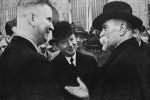 Much of what has been written in the media on Jan Bata can be classified as fake news. Fake stories because they are based on either political or economic interests who had an interest stopping the commercial success of Jan Antonin Bata and his enterprises. It does not require much investigation to see through the façade.
Much of what has been written in the media on Jan Bata can be classified as fake news. Fake stories because they are based on either political or economic interests who had an interest stopping the commercial success of Jan Antonin Bata and his enterprises. It does not require much investigation to see through the façade.
Let's start with the example of the Wage and Hour Division's investigation against Bata back in 1939-1940. The development of the case can be seen through the FBI report that followed.
First, the person who brought the claim against Bata was a former employee named Walter Buskey of Hickory, Maryland. He brought his complaint on July 13, 1939 with the support of a number of unions. According to one FBI report, "It was noted that inspectors of the Wage and Hour Division of had been unable to locate this complainant." In other words, the primary complainant Walter Buskey could not be found or interviewed. But, that didn't matter, the Wage and Hour Division of the Department of Labor continued the complaint against Bata based on Buskey's allegation along with the supporting complainants of the unions.
The unions behind Buskey complaint were:
1. Meyer Adelman, Secretary Treasurer of the Milwaukee Company, Industrial Union Council, C.I.O. Adelman complained by letter dated November 17, 1939 opposing the permission that Bata had received from the U.S. government for the entry of five hundred instructors to enter the United States.
2. Leo Gooman, Research Director of The United Shoe Worker of America, C.I.O. Goodman complained that Bata's deductions from salaries in Belcamp had brought wages below the hourly rate and that the company was offering too many overtime hours to its employees.
3. Sarah Barran, an organizer for the Alamgamated Clothing Workers of America (a niece of Steve Dulaney who was a member of the American Union). Barran complained that she had not earned minimum wage. Who knows if this is true?
The most important fact in this case was that the original complainant Walter Buskey could not located or interviewed in the case. This makes the case dubious at best. The rest of the case gets even weaker by the unions. Leo Goodman a union research director was desperately trying to connect Bata to Germany (for obvious reasons as German had recently invaded Czechoslovakia). At the same time, Bata was caught in the trap that by helping the Czechoslovak refugees, Jewish and others by listing them as instructors. An by protecting these employees, it limited what he could do to protect himself or his company. The environment for helping Jews was not popular in the United States at that time. The only logical solution was for Bata would be to pay the fine and move on. Bata was only guilty of helping his countrymen who had become refugees and attempting to build an enterprise in Belcamp, Maryland. Recall that of the 600 employees at the Bata plant at the time, only 75 were of Czechoslovak origin.
So, what was in the complaint?
The complaint was initiated by Walter Buskey a former employee who could not be contacted or interviewed.
The complaint alleged that Bata was allowing its workers too much overtime.
The unions complained that Bata should not be allowed to bring in five hundred Czechoslovak instructors (that had already been agreed to by the government).
The unions complained that Bata's machinery was coming from Germany (The machinery actually came from Czechoslovakia).
What was the outcome?
Bata was ordered to pay a fine which included back pay to employees which amounted to $13.47 per employee.
It was very convenient for the unions that Germany had invaded Czechoslovakia.
It does not take an expert to understand the motives behind the efforts to stop Bata from building a large-scale enterprise in America. It is clear that at a minimum his opponents included the unions, and likely much bigger interests.
John Nash Bata
2.4.2017
* * *
Karel Aster co-worker of Jan A. Baťa
J.Š.6.4.2017